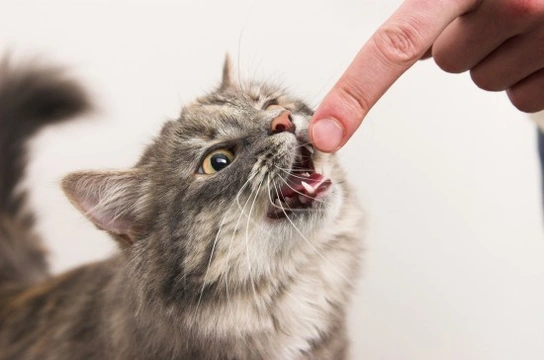
How to stop your cat from scratching or biting in play
As all cat owners will be aware, training the cat is certainly not in the same league as training the dog! While dogs can be taught to retain and respond to wide range of training commands, the cat is more of an independent animal that has a tendency to go its own way and do exactly what it likes regardless of what you as their owner might prefer them to do! This is a large part of the appeal of the cat, and something that cat owners must both expect and respect before taking on ownership (or being owned by a cat)! Nevertheless, if your cat manifests certain undesirable behaviours, such a scratching or biting when playing or without provocation, you are undoubtedly likely to wish to put a stop to this behaviour!
While it is usually fair to say that the cat cannot be “trained” per se, cats are intelligent animals that learn from their experiences, and can soon establish if something that they are doing is likely to provoke a positive or negative reaction from their owners. It is entirely possible, therefore, to manage and eradicate play scratching or biting in the cat, and over time, to minimise the likelihood of this happening to you by following some of the following tips.
Don’t create problems for yourself
Pouncing, simulated hunting and stalking prey are all natural cat behaviours, and ones that you will not only be unable to eradicate or prevent, but that are also healthy and necessary to allow. However, it is important to pay some mind as to how you do this, and how you play with your cat (particularly when they are young) and how you enable them to play out these natural behaviours.
Enabling chasing games with a toy or feather, providing scratching posts and watching and enabling your cat to hunt and chase after things are all great, but know where to draw the line. Don’t teach your cat to pounce on your fingers, or use your fingers to simulate a toy for them to pounce on! Many cats will become intrigued by the movement of feet or hands under the duvet or a cushion, and it can be highly amusing to watch cats chasing the “duvet mouse” or pouncing on your well- protected extremities. Do not, however, encourage your cat to attack your feet or hands if they become exposed, or you might find yourself on the receiving end of a rude wake-up call when your cat decides to grab hold of them when you are fast asleep!
Don’t wind your cat up
If you are playing with your cat or wish to play with them and they are becoming irritated or are not interested in playing, do not continue to try to provoke a reaction out of them. This is not only unfair to your cat, but can result in a nasty swipe with the paw or potential bite for you. Respect your cat’s personal space and need for quiet time, and let them be the ones to instigate games or play if you are uncertain of their mood.
Know when to cool things down
When playing with your cat, it is possible for the cat to become over stimulated and lose sight of the fact that they are involved in a game and not an actual hunt! As your cat becomes progressively more excited with play, keep an eye to ensure that they are not simultaneously becoming freer with their teeth or claws, and know when to take a step back and allow your cat to cool off!
Learn to read your cat’s signals
Learning to identify the signs and signals that your cat gives off is important, in order to establish if they really are sitting quietly and enjoying what you are doing or are about to pounce! Learn to tell the difference between an excited tail swish and an angry one, and never ignore warning signs such as hissing, flattened ears or growling.
Responding to things going too far
If your cat does nip you, bite you or scratch, how you respond to this is important. Say “no!” sharply, and immediately stop the game. If your cat does not seem to have noticed your change in demeanour, either remove them from the room or remove yourself until they have had a chance to cool down.
Repetition
Responding to your cat biting or scratching with consistency is important. Make sure that you react in the same way every time, letting your cat know that you are displeased but never losing your cool. Do not vary your response if your cat only bites gently or doesn’t hurt you; make sure that your cat comes to learn that involving their teeth or claws in the game is not allowed, to any degree, at any time.
Don’t lose your cool
However much of a shock it causes if your cat does take swipe at you or nips you, always be aware of your response and make sure your cat gets that you are displeased without frightening them. Never yell at your cat, and absolutely never smack them or physically respond to what has happened. Scaring your cat or breaking their trust can take a long time to put right, and will make for an uneasy and insecure living environment for your cat.
Supervising children
Always be mindful of how your children act towards your cat, and don’t leave young children alone with your cat if they cannot be trusted to respect your cat’s space. Teach your children to be mindful of your cat and their personal space, and what kind of games and play are ok and not ok, and importantly, when to call things a day.



